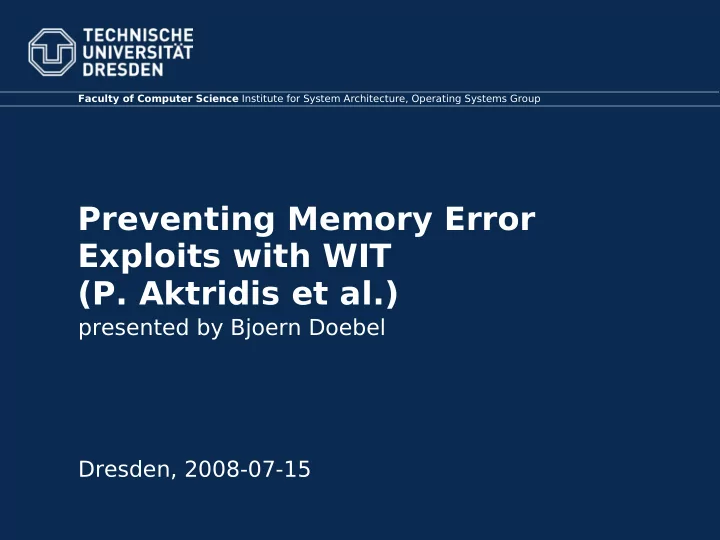

Faculty of Computer Science Institute for System Architecture, Operating Systems Group Preventing Memory Error Exploits with WIT (P. Aktridis et al.) presented by Bjoern Doebel Dresden, 2008-07-15
Motivation • Memory errors – Buffer overflows – Dangling pointers – Multiple frees • Lots of tools • Still account for nearly half of all security vulnerabilities. • Crappy tools? • Usability • Performance Overhead • Bug coverage
Reading Group History • Vigilante [Costa05] & Bouncer [Costa07] – Detect and propagate exploits through the internet (self-certifying alerts) – Aim: identify malicious input and automatically generate filters • Data-Flow Integrity Checking [Costa06] – Static checking: for each memory location determine the write locations that are allowed to modify it – Runtime instrumentation: for each write operation check, whether memory target is in set of allowed writes – Up to 100% CPU and 50% memory overhead
Write Integrity Testing (WIT) • Static Analysis: – Compute CFG – Determine objects that can be written by each instruction (safe vs. unsafe operations and objects) • Compiler Extension – Insert runtime checking and guard objects • Runtime Checking – Check all unsafe operations using object “colors”
Statically analyzing a memory exploit Safe vs. unsafe instructions Safe vs. unsafe variables
Adding instrumentation • For each unsafe variable p: – Calculate p's points-to set – Assign individual color {2..256} – Assign same color to unsafe operations writing to p • Merge colors for overlapping points-to-sets • Generate code checking colors for each unsafe instruction • Guards between unsafe objects (may still have the same color)
Instrumentation (2) • Checks only for unsafe write operations – Explicitly do not catch out-of-bounds reads • Wrap heap malloc/free routines to update color table • Instrument functions to update stack frames before and after function execution • Separate version of WIT to catch libc exploits • Similar handling of function pointers
Performance • SPEC and Olden benchmarks • 256 colors seem to be enough
Remarks / Questions • No support for user-defined memory allocators (but easily solved). • Can we think of an application where 256 colors are insufficient? – Need many dynamic allocations of small, independent objects • Given the fact, that we find unsafe objects during SA, why not just smash the programmer's head with a large wooden hammer? (thx, Marcus)
Recommend
More recommend